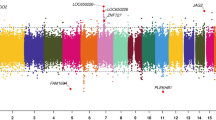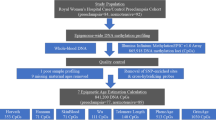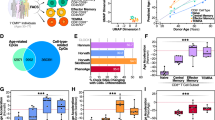Abstract
Background
Prematurity in itself and exposure to neonatal intensive care triggers inflammatory processes and oxidative stress, leading to risk for disease later in life. The effects on cellular aging processes are incompletely understood.
Methods
Relative telomere length (RTL) was measured by qPCR in this longitudinal cohort study with blood samples taken at birth and at 2 years of age from 60 children (16 preterm and 44 term). Viral respiratory infections the first year were evaluated. Epigenetic biological DNA methylation (DNAm) age was predicted based on methylation array data in 23 children (11 preterm and 12 term). RTL change/year and DNAm age change/year was compared in preterm and term during the 2 first years of life.
Results
Preterm infants had longer telomeres than term born at birth and at 2 years of age, but no difference in telomere attrition rate could be detected. Predicted epigenetic DNAm age was younger in preterm infants, but rate of DNAm aging was similar in both groups.
Conclusions
Despite early exposure to risk factors for accelerated cellular aging, children born preterm exhibited preserved telomeres. Stress during the neonatal intensive care period did not reflect accelerated epigenetic DNAm aging. Early-life aging was not explained by preterm birth.
Impact
-
Preterm birth is associated with elevated disease risk later in life.
-
Preterm children often suffer from inflammation early in life.
-
Stress-related telomere erosion during neonatal intensive care has been proposed.
-
Inflammation-accelerated biological aging in preterm is unknown.
-
We find no accelerated aging due to prematurity or infections during the first 2 years of life.
Similar content being viewed by others
Log in or create a free account to read this content
Gain free access to this article, as well as selected content from this journal and more on nature.com
or
References
Saugstad, O. D. Oxidative stress in the newborn–a 30-year perspective. Biol. Neonate 88, 228–236 (2005).
Johansson, S. et al. Risk of high blood pressure among young men increases with the degree of immaturity at birth. Circulation 112, 3430–3436 (2005).
Hadchouel, A. et al. Salivary telomere length and lung function in adolescents born very preterm: a prospective multicenter study. PLoS ONE 10, e0136123 (2015).
Crump, C., Sundquist, K., Sundquist, J. & Winkleby, M. A. Gestational age at birth and mortality in young adulthood. JAMA 306, 1233–1240 (2011).
Saretzki, G. & Von Zglinicki, T. Replicative aging, telomeres, and oxidative stress. Ann. NY Acad. Sci. 959, 24–29 (2002).
Masi, S. et al. Oxidative stress, chronic inflammation, and telomere length in patients with periodontitis. Free Radic. Biol. Med. 50, 730–735 (2011).
Menon, R. et al. Short fetal leukocyte telomere length and preterm prelabor rupture of the membranes. PLoS ONE 7, e31136 (2012).
Marseglia, L. et al. Oxidative stress-mediated aging during the fetal and perinatal periods. Oxid. Med. Cell Longev. 2014, 358375 (2014).
Aviv, A. & Levy, D. Telomeres, atherosclerosis, and the hemothelium: the longer view. Annu. Rev. Med. 63, 293–301 (2012).
Norrback, K. F. & Roos, G. Telomeres and telomerase in normal and malignant haematopoietic cells. Eur. J. Cancer 33, 774–780 (1997).
Frenck, R. W., Blackburn, E. H. & Shannon, K. M. The rate of telomere sequence loss in human leukocytes varies with age. Proc. Natl Acad. Sci. USA 95, 5607–5610 (1998).
Friedrich, U. et al. Telomeres in neonates: new insights in fetal hematopoiesis. Pediatr. Res. 49, 252–256 (2001).
Holmes, D. K. et al. Telomere length dynamics differ in foetal and early post-natal human leukocytes in a longitudinal study. Biogerontology 10, 279–284 (2009).
Nordfjäll, K. et al. Telomere length and heredity: indications of paternal inheritance. Proc. Natl Acad. Sci. USA 102, 16374–16378 (2005).
de Goede, O. M., Lavoie, P. M. & Robinson, W. P. Cord blood hematopoietic cells from preterm infants display altered DNA methylation patterns. Clin. Epigenet. 9, 39 (2017).
Baerlocher, G. M., Rice, K., Vulto, I. & Lansdorp, P. M. Longitudinal data on telomere length in leukocytes from newborn baboons support a marked drop in stem cell turnover around 1 year of age. Aging Cell 6, 121–123 (2007).
Vasu, V. et al. Preterm infants have significantly longer telomeres than their term born counterparts. PLoS ONE 12, e0180082 (2017).
Provenzi, L. et al. Pain exposure associates with telomere length erosion in very preterm infants. Psychoneuroendocrinology 89, 113–119 (2018).
Akkad, A. et al. Telomere length in small-for-gestational-age babies. BJOG 113, 318–323 (2006).
Henckel, E. et al. Telomere length was similar in school-age children with bronchopulmonary dysplasia and allergic asthma. Acta Paediatr. 107, 1395–1401 (2018).
Horvath, S. DNA methylation age of human tissues and cell types. Genome Biol. 14, R115 (2013).
Casavant, S. G., Cong, X., Moore, J. & Starkweather, A. Associations between preterm infant stress, epigenetic alteration, telomere length and neurodevelopmental outcomes: a systematic review. Early Hum. Dev. 131, 63–74 (2019).
de Onis, M. et al. Development of a WHO growth reference for school-aged children and adolescents. Bull. World Health Organ. 85, 660–667 (2007).
Cawthon, R. M. Telomere measurement by quantitative PCR. Nucleic Acids Res. 30, e47 (2002).
Degerman, S. et al. Immortalization of T-cells is accompanied by gradual changes in CpG methylation resulting in a profile resembling a subset of T-cell leukemias. Neoplasia 16, 606–615 (2014).
Factor-Litvak, P. et al. Leukocyte telomere length in newborns: implications for the role of telomeres in human disease. Pediatrics 137, e20153927 (2016).
Robertson, J. D. et al. Dynamics of telomere shortening in neutrophils and T lymphocytes during ageing and the relationship to skewed X chromosome inactivation patterns. Br. J. Haematol. 109, 272–279 (2000).
Shlush, L. I. et al. Telomere elongation followed by telomere length reduction, in leukocytes from divers exposed to intense oxidative stress–implications for tissue and organismal aging. Mech. Ageing Dev. 132, 123–130 (2011).
Rufer, N. et al. Telomere fluorescence measurements in granulocytes and T lymphocyte subsets point to a high turnover of hematopoietic stem cells and memory T cells in early childhood. J. Exp. Med. 190, 157–167 (1999).
Olin, A. et al. Stereotypic immune system development in newborn children. Cell 174, 1277.e14–1292.e14 (2018).
Wojcicki, J. M. et al. Early exclusive breastfeeding is associated with longer telomeres in Latino preschool children. Am. J. Clin. Nutr. 104, 397–405 (2016).
Wojcicki, J. M., Medrano, R., Lin, J. & Epel, E. Increased cellular aging by 3 years of age in latino, preschool children who consume more sugar-sweetened beverages: a pilot study. Child Obes. 14, 149–157 (2018).
Vetter, V. M. et al. Epigenetic clock and relative telomere length represent largely different aspects of aging in the Berlin Aging Study II (BASE-II). J. Gerontol. A Biol. Sci. Med. Sci. 74, 27–32 (2019).
Svenson, U. et al. Blood cell telomere length is a dynamic feature. PLoS ONE 6, e21485 (2011).
Ahmed, S. et al. Telomerase does not counteract telomere shortening but protects mitochondrial function under oxidative stress. J. Cell Sci. 121, 1046–1053 (2008).
Haendeler, J. et al. Mitochondrial telomerase reverse transcriptase binds to and protects mitochondrial DNA and function from damage. Arterioscler. Thromb. Vasc. Biol. 29, 929–935 (2009).
Martino, D. et al. Longitudinal, genome-scale analysis of DNA methylation in twins from birth to 18 months of age reveals rapid epigenetic change in early life and pair-specific effects of discordance. Genome Biol. 14, R42 (2013).
Urdinguio, R. G. et al. Longitudinal study of DNA methylation during the first 5 years of life. J. Transl. Med. 14, 160 (2016).
Schlinzig, T. et al. Epigenetic modulation at birth - altered DNA-methylation in white blood cells after Caesarean section. Acta Paediatr. 98, 1096–1099 (2009).
Wang, D. et al. Individual variation and longitudinal pattern of genome-wide DNA methylation from birth to the first two years of life. Epigenetics 7, 594–605 (2012).
Acknowledgements
We are grateful to Charlotte Palme-Kilander who initiated and conceptionalized the LUFT study and who together with research nurse Maria Hammargren included a big part of the cohort. We sincerely thank Professor Göran Roos, Umeå University for invaluable advice and sharing his vast knowledge on telomere biology; to Susann Haraldsson, Umeå University for telomere length measurements; and to Professor Matteo Bottai, Karolinska Institutet for statistical assistance. The study was supported by grants from Her Royal Highness Crown Princess Lovisa’s Fund for Scientific Research, The Samariten Foundation for Paediatric Research, Lilla Barnets Fond, the Medical Faculty of Umeå University, Lion’s Cancer Research Foundation at Umeå University, the Kempe Foundations, and General Maternity Hospital Foundation. Financial support was provided through a regional agreement between Umeå University and Västerbotten County Council on cooperation in the field of Medicine, Odontology, and Health.
Author information
Authors and Affiliations
Contributions
Conceptualization and writing—original draft, E.H., K.B., S.D.; data acquisition, analysis, and/or interpretation, writing—review and editing, and final approval: all authors.
Corresponding author
Ethics declarations
Competing interests
The authors declare no competing interests.
Additional information
Publisher’s note Springer Nature remains neutral with regard to jurisdictional claims in published maps and institutional affiliations.
Supplementary Information
Rights and permissions
About this article
Cite this article
Henckel, E., Landfors, M., Haider, Z. et al. Hematopoietic cellular aging is not accelerated during the first 2 years of life in children born preterm. Pediatr Res 88, 903–909 (2020). https://doi.org/10.1038/s41390-020-0833-6
Received:
Revised:
Accepted:
Published:
Issue date:
DOI: https://doi.org/10.1038/s41390-020-0833-6
This article is cited by
-
Using Epigenetic Clocks to Characterize Biological Aging in Studies of Children and Childhood Exposures: a Systematic Review
Prevention Science (2023)
-
Long-Term Follow-Up of Newborns with 22q11 Deletion Syndrome and Low TRECs
Journal of Clinical Immunology (2022)



